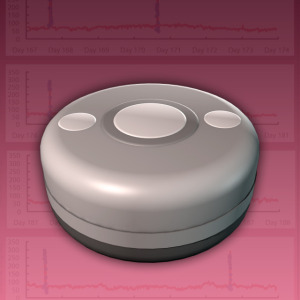by
Brendon Nafziger, DOTmed News Associate Editor | July 29, 2010

The sensor lasts up
to one year.
(Image C. Bickel/Science
Translational Medicine
© 2010 AAAS)
One of the goals of diabetes research is to come up with an
artificial pancreas that can monitor blood glucose levels in real-time and respond to them by releasing insulin just as a normal pancreas would. But a challenge has been creating a device that can be implanted in the body and last for a long time while accurately measuring blood glucose levels.
Now, scientists have announced an important milestone in glucose monitoring.
In a study published Wednesday in Science Translational Medicine, researchers said they created a wireless glucose sensor that can be implanted under the skin and that was able to accurately measure glucose for nearly a year.
The one-and-a-half inch-diameter device, which was implanted in pigs, uses two sensors. One monitors changes in oxygen levels that are affected by glucose and oxygen interacting with enzymes immobilized within a gel in the sensor. The other sensor monitors background oxygen levels.
The device then compares the two results to figure out tissue glucose levels, which can be related to blood glucose values.
The dual-sensor strategy is the "core achievement," said David Gough, lead author of the paper and a professor of bioengineering at the University of California in San Diego. That's because by checking background oxygen levels, it helps ensure accurate readings even as tissue around the device changes as part of the body's natural response to an implant.
This meant the device could be used for over 500 days after implantation, Gough said.
"Part of the interesting achievement here, during the first 160-plus days, the sensor remained remarkably stable," Gough told DOTmed News. "When we get to the point of doing human studies, one of the interesting questions will be how long an interval can go between recalibration times."
In the study, the devices in pigs got recalibrated about once every couple of months, Gough said, by setting the device against blood glucose levels measured by blood drawn from a catheter in the pigs.
And the tiny implant appears to be fairly accurate.
"These results suggest that, although there may be quantifiable differences between the actual blood glucose concentrations and values reported by the sensor, none of these differences would lead to a mistaken, potentially dangerous clinical action," the authors write in the study.
The sensor has a lag time of about 12 minutes for rising blood glucose and seven minutes for falling blood glucose, on par with other commercial glucose readers, Gough said.
